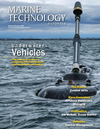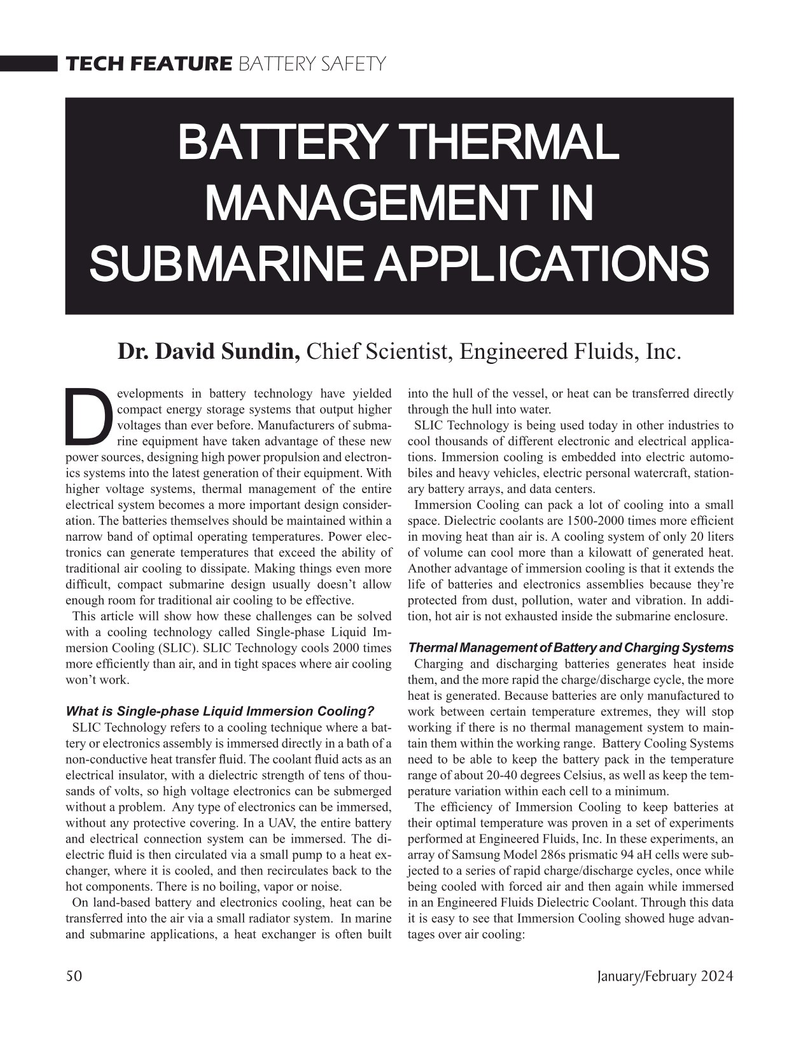
Page 50: of Marine Technology Magazine (January 2024)
Read this page in Pdf, Flash or Html5 edition of January 2024 Marine Technology Magazine
TECH FEATURE BATTERY SAFETY
BATTERY THERMAL
MANAGEMENT IN
SUBMARINE APPLICATIONS
Dr. David Sundin, Chief Scientist, Engineered Fluids, Inc.
evelopments in battery technology have yielded into the hull of the vessel, or heat can be transferred directly compact energy storage systems that output higher through the hull into water.
voltages than ever before. Manufacturers of subma- SLIC Technology is being used today in other industries to
D rine equipment have taken advantage of these new cool thousands of different electronic and electrical applica- power sources, designing high power propulsion and electron- tions. Immersion cooling is embedded into electric automo- ics systems into the latest generation of their equipment. With biles and heavy vehicles, electric personal watercraft, station- higher voltage systems, thermal management of the entire ary battery arrays, and data centers.
electrical system becomes a more important design consider- Immersion Cooling can pack a lot of cooling into a small ation. The batteries themselves should be maintained within a space. Dielectric coolants are 1500-2000 times more ef? cient narrow band of optimal operating temperatures. Power elec- in moving heat than air is. A cooling system of only 20 liters tronics can generate temperatures that exceed the ability of of volume can cool more than a kilowatt of generated heat. traditional air cooling to dissipate. Making things even more Another advantage of immersion cooling is that it extends the dif? cult, compact submarine design usually doesn’t allow life of batteries and electronics assemblies because they’re enough room for traditional air cooling to be effective. protected from dust, pollution, water and vibration. In addi-
This article will show how these challenges can be solved tion, hot air is not exhausted inside the submarine enclosure.
with a cooling technology called Single-phase Liquid Im- mersion Cooling (SLIC). SLIC Technology cools 2000 times Thermal Management of Battery and Charging Systems more ef? ciently than air, and in tight spaces where air cooling Charging and discharging batteries generates heat inside won’t work. them, and the more rapid the charge/discharge cycle, the more heat is generated. Because batteries are only manufactured to
What is Single-phase Liquid Immersion Cooling? work between certain temperature extremes, they will stop
SLIC Technology refers to a cooling technique where a bat- working if there is no thermal management system to main- tery or electronics assembly is immersed directly in a bath of a tain them within the working range. Battery Cooling Systems non-conductive heat transfer ? uid. The coolant ? uid acts as an need to be able to keep the battery pack in the temperature electrical insulator, with a dielectric strength of tens of thou- range of about 20-40 degrees Celsius, as well as keep the tem- sands of volts, so high voltage electronics can be submerged perature variation within each cell to a minimum. without a problem. Any type of electronics can be immersed, The ef? ciency of Immersion Cooling to keep batteries at without any protective covering. In a UAV, the entire battery their optimal temperature was proven in a set of experiments and electrical connection system can be immersed. The di- performed at Engineered Fluids, Inc. In these experiments, an electric ? uid is then circulated via a small pump to a heat ex- array of Samsung Model 286s prismatic 94 aH cells were sub- changer, where it is cooled, and then recirculates back to the jected to a series of rapid charge/discharge cycles, once while hot components. There is no boiling, vapor or noise. being cooled with forced air and then again while immersed
On land-based battery and electronics cooling, heat can be in an Engineered Fluids Dielectric Coolant. Through this data transferred into the air via a small radiator system. In marine it is easy to see that Immersion Cooling showed huge advan- and submarine applications, a heat exchanger is often built tages over air cooling: 50 January/February 2024
MTR #1 (50-63).indd 50 1/31/2024 8:33:48 AM

 49
49

 51
51
